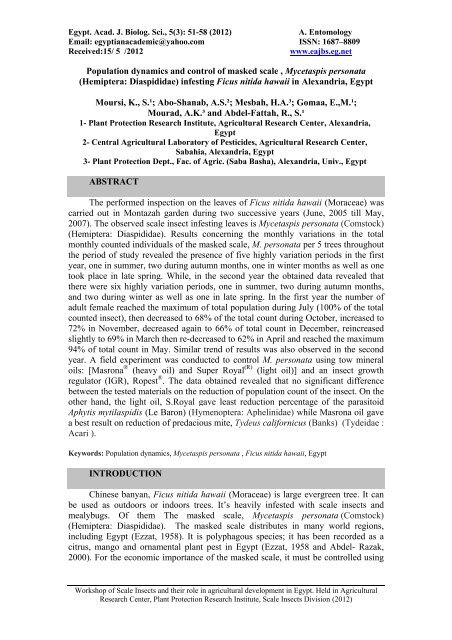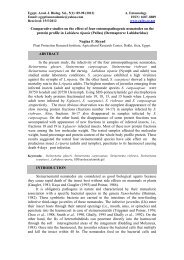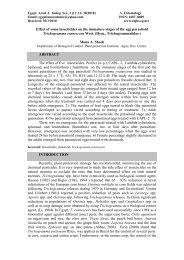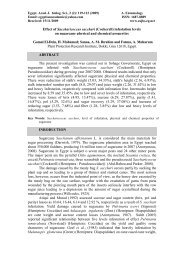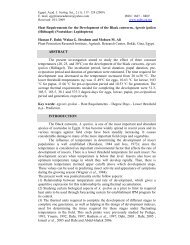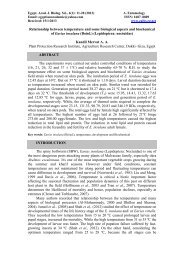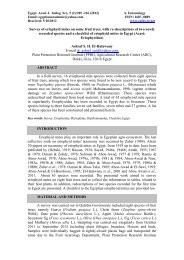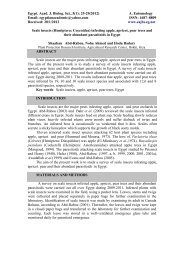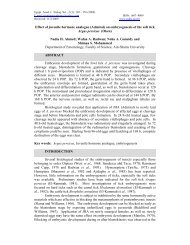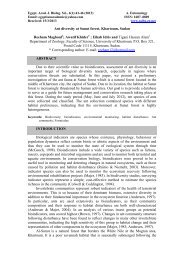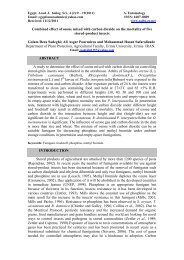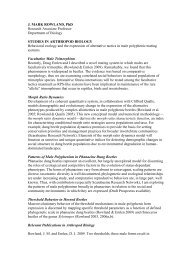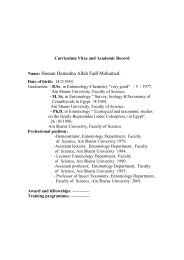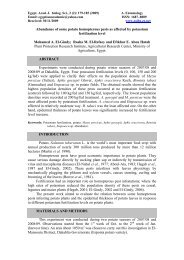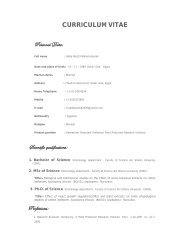(Hemiptera: Diaspididae) infesting Ficus nitida hawaii in
(Hemiptera: Diaspididae) infesting Ficus nitida hawaii in
(Hemiptera: Diaspididae) infesting Ficus nitida hawaii in
You also want an ePaper? Increase the reach of your titles
YUMPU automatically turns print PDFs into web optimized ePapers that Google loves.
Egypt. Acad. J. Biolog. Sci., 5(3): 51-58 (2012) A. Entomology<br />
Email: egyptianacademic@yahoo.com ISSN: 1687–8809<br />
Received:15/ 5 /2012 www.eajbs.eg.net<br />
Population dynamics and control of masked scale , Mycetaspis personata<br />
(<strong>Hemiptera</strong>: <strong>Diaspididae</strong>) <strong><strong>in</strong>fest<strong>in</strong>g</strong> <strong>Ficus</strong> <strong>nitida</strong> <strong>hawaii</strong> <strong>in</strong> Alexandria, Egypt<br />
Moursi, K., S.¹; Abo-Shanab, A.S.²; Mesbah, H.A.³; Gomaa, E.,M.¹;<br />
Mourad, A.K.³ and Abdel-Fattah, R., S.¹<br />
1- Plant Protection Research Institute, Agricultural Research Center, Alexandria,<br />
Egypt<br />
2- Central Agricultural Laboratory of Pesticides, Agricultural Research Center,<br />
Sabahia, Alexandria, Egypt<br />
3- Plant Protection Dept., Fac. of Agric. (Saba Basha), Alexandria, Univ., Egypt<br />
ABSTRACT<br />
The performed <strong>in</strong>spection on the leaves of <strong>Ficus</strong> <strong>nitida</strong> <strong>hawaii</strong> (Moraceae) was<br />
carried out <strong>in</strong> Montazah garden dur<strong>in</strong>g two successive years (June, 2005 till May,<br />
2007). The observed scale <strong>in</strong>sect <strong><strong>in</strong>fest<strong>in</strong>g</strong> leaves is Mycetaspis personata (Comstock)<br />
(<strong>Hemiptera</strong>: <strong>Diaspididae</strong>). Results concern<strong>in</strong>g the monthly variations <strong>in</strong> the total<br />
monthly counted <strong>in</strong>dividuals of the masked scale, M. personata per 5 trees throughout<br />
the period of study revealed the presence of five highly variation periods <strong>in</strong> the first<br />
year, one <strong>in</strong> summer, two dur<strong>in</strong>g autumn months, one <strong>in</strong> w<strong>in</strong>ter months as well as one<br />
took place <strong>in</strong> late spr<strong>in</strong>g. While, <strong>in</strong> the second year the obta<strong>in</strong>ed data revealed that<br />
there were six highly variation periods, one <strong>in</strong> summer, two dur<strong>in</strong>g autumn months,<br />
and two dur<strong>in</strong>g w<strong>in</strong>ter as well as one <strong>in</strong> late spr<strong>in</strong>g. In the first year the number of<br />
adult female reached the maximum of total population dur<strong>in</strong>g July (100% of the total<br />
counted <strong>in</strong>sect), then decreased to 68% of the total count dur<strong>in</strong>g October, <strong>in</strong>creased to<br />
72% <strong>in</strong> November, decreased aga<strong>in</strong> to 66% of total count <strong>in</strong> December, re<strong>in</strong>creased<br />
slightly to 69% <strong>in</strong> March then re-decreased to 62% <strong>in</strong> April and reached the maximum<br />
94% of total count <strong>in</strong> May. Similar trend of results was also observed <strong>in</strong> the second<br />
year. A field experiment was conducted to control M. personata us<strong>in</strong>g tow m<strong>in</strong>eral<br />
oils: [Masrona ® (heavy oil) and Super Royal (R) (light oil)] and an <strong>in</strong>sect growth<br />
regulator (IGR), Ropest ® . The data obta<strong>in</strong>ed revealed that no significant difference<br />
between the tested materials on the reduction of population count of the <strong>in</strong>sect. On the<br />
other hand, the light oil, S.Royal gave least reduction percentage of the parasitoid<br />
Aphytis mytilaspidis (Le Baron) (Hymenoptera: Aphel<strong>in</strong>idae) while Masrona oil gave<br />
a best result on reduction of predacious mite, Tydeus californicus (Banks) (Tydeidae :<br />
Acari ).<br />
Keywords: Population dynamics, Mycetaspis personata , <strong>Ficus</strong> <strong>nitida</strong> <strong>hawaii</strong>, Egypt<br />
INTRODUCTION<br />
Ch<strong>in</strong>ese banyan, <strong>Ficus</strong> <strong>nitida</strong> <strong>hawaii</strong> (Moraceae) is large evergreen tree. It can<br />
be used as outdoors or <strong>in</strong>doors trees. It’s heavily <strong>in</strong>fested with scale <strong>in</strong>sects and<br />
mealybugs. Of them The masked scale, Mycetaspis personata (Comstock)<br />
(<strong>Hemiptera</strong>: <strong>Diaspididae</strong>). The masked scale distributes <strong>in</strong> many world regions,<br />
<strong>in</strong>clud<strong>in</strong>g Egypt (Ezzat, 1958). It is polyphagous species; it has been recorded as a<br />
citrus, mango and ornamental plant pest <strong>in</strong> Egypt (Ezzat, 1958 and Abdel- Razak,<br />
2000). For the economic importance of the masked scale, it must be controlled us<strong>in</strong>g<br />
Workshop of Scale Insects and their role <strong>in</strong> agricultural development <strong>in</strong> Egypt. Held <strong>in</strong> Agricultural<br />
Research Center, Plant Protection Research Institute, Scale Insects Division (2012)
52<br />
Moursi, K., S. et al.<br />
an alternative effective and relatively environmental safe scalicides such as IGR,s and<br />
m<strong>in</strong>eral oils (MARL, 1997 and Abo-Shanab,2005).<br />
The present work aimed to add some ecological notes on this coccoid species on<br />
one of the important ornamental tree <strong>in</strong> public and private gardens. Also, the study<br />
aimed to evaluate the efficacy of two local m<strong>in</strong>eral oils (heavy and light) and an IGR<br />
for controll<strong>in</strong>g the masked scale.<br />
MATERIALS AND METHODS<br />
1. Ecological study:<br />
Survey and <strong>in</strong>spection were started from March 2005 till February 2007 <strong>in</strong><br />
Montazah public gardens <strong>in</strong> Alexandria Governorate. The trees were not exposed to<br />
any pesticides treatments dur<strong>in</strong>g the period of study. Five trees were randomly chosen<br />
to the survey of the scale <strong>in</strong>sect. Ten leaves were monthly picked out at random, from<br />
each direction of <strong>in</strong>spected tree. Leaves were put <strong>in</strong> cloth bags; transported<br />
immediately to the laboratory for classify<strong>in</strong>g and count<strong>in</strong>g the exist<strong>in</strong>g <strong>in</strong>dividuals of<br />
detected species us<strong>in</strong>g a stereoscopic b<strong>in</strong>ocular microscope. The upper and lower<br />
surfaces of the leaves were carefully exam<strong>in</strong>ed. The rate of <strong>in</strong>crease/decrease <strong>in</strong><br />
population densities was calculated by divid<strong>in</strong>g the mean number of <strong>in</strong>sects found <strong>in</strong><br />
the sample over that found <strong>in</strong> preced<strong>in</strong>g one (Bodenheimer, 1951).<br />
2. Chemical study:<br />
A field experiment was carried out <strong>in</strong> August, 2008 <strong>in</strong> Mountazah garden.<br />
Three treatments were used as well as control, replicated five times, were randomly<br />
districted over 20 trees. The tested scalicides were two local m<strong>in</strong>eral oils namely<br />
Masrona oil ® (heavy oil) [85% mayonnaise, produced by Misr Petroleum Co.] and<br />
Super Royal oil ® (light oil) [95% E.C, produced by El-Gameia El-Taawnia for<br />
Petroleum Co.] and one IGR called Ropest ® [produced by Shoura Chemicals, Co.] at<br />
concentrations of 2.5%, 1.5% and 0.125%, respectively. Pre-treatment count was<br />
made before spray and four post counts were made after 2, 4, 6, and 8 weeks after<br />
spray. The liv<strong>in</strong>g scales were exam<strong>in</strong>ed on 10 leaves from each tree. To evaluate the<br />
efficacy of the tested materials, the percentage of reduction was determ<strong>in</strong>ed accord<strong>in</strong>g<br />
to Stafford and Summers (1963) for scale <strong>in</strong>sect and Henderson and Tilton (1955) for<br />
parasitoid and predacious mite. In an effort to estimate the distribution and population<br />
densities of the detected scale <strong>in</strong>sect, the obta<strong>in</strong>ed results were statistically analyzed<br />
accord<strong>in</strong>g to (Snedecor, 1970).<br />
RESULTS AND DISCUSSION<br />
1. Ecological study:<br />
Data <strong>in</strong> Table (1) and Fig. (1) show the calculated monthly variations <strong>in</strong><br />
population density of the masked scale, M. personata <strong><strong>in</strong>fest<strong>in</strong>g</strong> F. <strong>nitida</strong> <strong>hawaii</strong> <strong>in</strong><br />
Montazah gardens dur<strong>in</strong>g the period of study. It is revealed that the relatively low<br />
total number of <strong>in</strong>sects/5trees <strong>in</strong> July month (357) <strong>in</strong>creased gradually to reach 1343<br />
<strong>in</strong>dividuals/5trees <strong>in</strong> September; represented 14.4% of the total collected <strong>in</strong>sect/year<br />
<strong>in</strong> September 2005, then decreased up to 511 <strong>in</strong>dividuals per 5trees represent<strong>in</strong>g 5.5%<br />
of total count/year <strong>in</strong> January, 2006, re-<strong>in</strong>creased aga<strong>in</strong> to reach 1215 <strong>in</strong>dividuals/tree<br />
and represented 13% of total count per year <strong>in</strong> February, 2006, then started to<br />
decrease aga<strong>in</strong> to reach 542 <strong>in</strong>dividuals/tree resembl<strong>in</strong>g 5.8% of total count/year <strong>in</strong><br />
April and so on re- <strong>in</strong>creased dur<strong>in</strong>g May to reach 868 <strong>in</strong>dividuals/tree (9.3% of total
Population dynamics and control of masked scale , Mycetaspis personata<br />
count ) to start another decrease <strong>in</strong> June and July of the next year (Table, 1 and Fig.<br />
1).<br />
Table 1: Monthly variations <strong>in</strong> population count of Mycetaspis personata <strong><strong>in</strong>fest<strong>in</strong>g</strong> <strong>Ficus</strong> <strong>nitida</strong> <strong>hawaii</strong><br />
dur<strong>in</strong>g 2005-2006 and 2006-2007 <strong>in</strong> Alexandria Governorate.<br />
Months<br />
Total count/5trees<br />
Quotient of<br />
<strong>in</strong>crease<br />
% of grand total<br />
count/year<br />
% of <strong>in</strong>spected<br />
Females<br />
% of <strong>in</strong>spected<br />
Males<br />
05-06 06-07 05-06 06-07 05-06 06-07 05-06 06-07 05-06 06-07<br />
June, 482 415 - - 5.3 5.2 92.0 88.0 8.0 12.0<br />
July 357 100 0.74 0.24 3.8 1.2 100.0 100.0 0.0 0.0<br />
August 715 799 2.00 8.00 7.6 9.9 86.2 91.0 14.0 9.0<br />
September 1343 559 1.88 0.70 14.4 6.9 72.0 72.0 28.0 28.0<br />
October 854 610 0.64 1.09 9.2 7.6 68.0 75.0 32.0 25.0<br />
November 856 763 1.00 1.25 9.2 9.5 72.0 74.0 28.0 26.0<br />
December 711 973 0.83 1028 7.6 12.1 66.0 58.0 34.0 42.0<br />
January 511 594 0.72 0.61 5.5 7.4 67.0 75.0 33.0 25.0<br />
February 1215 1052 2.38 1.77 13.0 13.1 68.0 65.0 32.0 35.0<br />
March 863 734 0.71 0.70 9.3 9.1 69.0 64.0 31.0 36.0<br />
April 542 462 0.63 0.63 5.8 5.7 62.0 62.0 38.0 38.0<br />
May 868 989 1.60 2.14 9.3 12.3 94.0 90.0 6.0 10.0<br />
Grand<br />
total/year<br />
9317 8050 % of grand total count/year 76.3 76.2 23.7 23.8<br />
Fig. 1: Percentage monthly variations of total count of Mycetaspis personata <strong>in</strong>fested <strong>Ficus</strong> <strong>nitida</strong><br />
<strong>hawaii</strong> dur<strong>in</strong>g (2005-2006 and 2006-2007) <strong>in</strong> Alexandria Governorate<br />
Here<strong>in</strong>, <strong>in</strong> the second year (June 2006, May 2007) the data showed similar trend<br />
of results but with slight difference, where the first high number of <strong>in</strong>sects was<br />
recorded <strong>in</strong> August (799 <strong>in</strong>dividuals/5trees represent<strong>in</strong>g 9.9% of grand total<br />
count/year). The second peak of <strong>in</strong>creased <strong>in</strong>sects was recorded <strong>in</strong> December (973<br />
<strong>in</strong>dividuals/5trees represent<strong>in</strong>g 12.1% of total count/year), then that highest number<br />
decreased up to 594 <strong>in</strong>dividuals/5trees (7.4% of total count/year) <strong>in</strong> January, re<strong>in</strong>creased<br />
aga<strong>in</strong> to a maximum of 1052 <strong>in</strong>dividuals/5trees (13.1% of total count ) <strong>in</strong><br />
February; further re-decreased up to 462 <strong>in</strong>sect/5trees <strong>in</strong> April, to give another<br />
<strong>in</strong>crease comprised 989 <strong>in</strong>dividuals/5trees (12.3% of total count/year) <strong>in</strong> May, 2007<br />
(Table 1 and Fig. 1); followed by a start of decrease <strong>in</strong> June & July of the next year.<br />
Moreover, the drastic effect of Khamas<strong>in</strong> hot w<strong>in</strong>ds was reflected also on the<br />
relatively lower number of total counted <strong>in</strong>dividuals/5trees <strong>in</strong> April month of both<br />
years.<br />
Results concern<strong>in</strong>g the monthly variations (Quotient of <strong>in</strong>crease, Q.I.) <strong>in</strong> the<br />
total monthly counted <strong>in</strong>dividuals of the masked scale, M. personata per 5 trees<br />
throughout the period of study revealed the presence of five highly variation periods<br />
<strong>in</strong> the first year, one <strong>in</strong> summer (2.0), two dur<strong>in</strong>g autumn months (1.88 & 1.0) one <strong>in</strong><br />
w<strong>in</strong>ter months (2.38) as well as another one detected <strong>in</strong> late spr<strong>in</strong>g (1.60) (Table1). In<br />
53
54<br />
Moursi, K., S. et al.<br />
the second year, the obta<strong>in</strong>ed data revealed that also there were six highly variation<br />
periods, one <strong>in</strong> summer (8.0), two dur<strong>in</strong>g autumn months (1.09 & 1.25), two dur<strong>in</strong>g<br />
w<strong>in</strong>ter (1.28 and 1.77) as well as one <strong>in</strong> late spr<strong>in</strong>g (2.14), (Table, 1). The exhibited<br />
results <strong>in</strong> (Table, 1 and Fig.2) showed that the estimated density values of the adult<br />
females of M. personata on F. <strong>nitida</strong> <strong>hawaii</strong> leaves. Whereas <strong>in</strong> the first year the<br />
calculated percentage of adult female reached the maximum of total population dur<strong>in</strong>g<br />
July.<br />
% of female and / or male<br />
120<br />
100<br />
80<br />
60<br />
40<br />
20<br />
0<br />
Female 05-06 Female 06-07<br />
Male 05-06 Male 06-07<br />
Months<br />
Fig. 2: Monthly calculated percentage of <strong>in</strong>spected females and males of Mycetaspis personata<br />
<strong><strong>in</strong>fest<strong>in</strong>g</strong> <strong>Ficus</strong> <strong>nitida</strong> <strong>hawaii</strong> dur<strong>in</strong>g 2005-2006 and 2006-2007 <strong>in</strong> Alexandria Governorate<br />
(100% of the monthly total counted <strong>in</strong>sects); then decreased to 68% of the total<br />
count dur<strong>in</strong>g October, <strong>in</strong>creased to 72% <strong>in</strong> November, decreased aga<strong>in</strong> to 66% of total<br />
count <strong>in</strong> December, re-<strong>in</strong>creased slightly to 69% <strong>in</strong> March then re-decreased to 62%<br />
<strong>in</strong> April and reached the maximum 94% of total count <strong>in</strong> May (Table 1). Similar<br />
trend of results was also observed <strong>in</strong> the second year (June, 2006-May, 2007), dur<strong>in</strong>g<br />
which the population of M. personata adult females reached 100% of total count<br />
dur<strong>in</strong>g July, then decreased to reach 58% of the total counted <strong>in</strong>sect dur<strong>in</strong>g December,<br />
re-<strong>in</strong>creased aga<strong>in</strong> to 75% <strong>in</strong> January, then re-decreased to 62% <strong>in</strong> April and reached<br />
highly percentage compris<strong>in</strong>g 90% of the total count dur<strong>in</strong>g May, 2007 (Table 1 and<br />
Fig.2). Concern<strong>in</strong>g the measured population density of adult males, their detected<br />
numbers were less than those of adult females throughout the year. By beg<strong>in</strong>n<strong>in</strong>g of<br />
summer months, the adult male of M. personata represented 8% of the total monthly<br />
counted <strong>in</strong>sects; disappeared completely dur<strong>in</strong>g July. Later, the calculated percentage<br />
of adult male dur<strong>in</strong>g August represented 14% of total counted <strong>in</strong>dividuals/month;<br />
followed <strong>in</strong>crease to reach 32% dur<strong>in</strong>g October, then decreased to 28% dur<strong>in</strong>g<br />
November; re <strong>in</strong>creased to 34% <strong>in</strong> December, then followed by decreased densities<br />
dur<strong>in</strong>g January, February and March and <strong>in</strong>creased aga<strong>in</strong> to reach the maximum (38%<br />
of total count) <strong>in</strong> April <strong>in</strong> the first year of study (Table 1). The same trend of results<br />
has been obta<strong>in</strong>ed dur<strong>in</strong>g the second year with a slight difference <strong>in</strong> the percentage of<br />
total count (Table1). These results are <strong>in</strong> agreement with the f<strong>in</strong>d<strong>in</strong>gs of Abdel Razak<br />
(2000) and Mesbah et al. (2003) who mentioned that the population of adult males of<br />
M. personata on F. <strong>nitida</strong> <strong>in</strong>creased dur<strong>in</strong>g October and reached high percentage<br />
dur<strong>in</strong>g w<strong>in</strong>ter and spr<strong>in</strong>g months. The seasonal variation <strong>in</strong> population density of<br />
occurr<strong>in</strong>g M. personata <strong>in</strong>dividuals on F. <strong>nitida</strong> <strong>hawaii</strong> are shown <strong>in</strong> (Fig.3). The data<br />
revealed that the highest population density of collected <strong>in</strong>dividuals was observed<br />
dur<strong>in</strong>g autumn months <strong>in</strong> the first year; comprised 3053 <strong>in</strong>dividuals that represent<br />
32.7 % of grand total count per year; while <strong>in</strong> the second year the highest population
Population dynamics and control of masked scale , Mycetaspis personata<br />
was recorded dur<strong>in</strong>g w<strong>in</strong>ter months with a total count of 2619 <strong>in</strong>dividuals that<br />
represent 32.5% of grand total count of collected <strong>in</strong>dividuals /year. The lowest<br />
population density of collected <strong>in</strong>dividuals occurred dur<strong>in</strong>g summer months;<br />
comprised 1554 and 1314 <strong>in</strong>dividuals that represent 16.7 and 16.3 % of grand total of<br />
collected ones/year <strong>in</strong> each of both successive years of study, <strong>in</strong> respect, (Fig. 3).<br />
Consider<strong>in</strong>g the efficacy of two local m<strong>in</strong>eral oils and IGR treatment to control the<br />
masked scale, the applications were made dur<strong>in</strong>g late summer (August) where the<br />
population of the <strong>in</strong>sect started to <strong>in</strong>crease to prevent this population to reach the peak<br />
dur<strong>in</strong>g September and October, so its population decreased dur<strong>in</strong>g the next season.<br />
35<br />
30<br />
25<br />
20<br />
15<br />
10<br />
5<br />
0<br />
2005- 2006 2006-2007<br />
Spr<strong>in</strong>g Summer Autumn W<strong>in</strong>ter<br />
Fig. 3: Seasonal variations <strong>in</strong> estimated population density of Mycetaspis personata on <strong>Ficus</strong> <strong>nitida</strong><br />
<strong>hawaii</strong> <strong>in</strong> Alexandria Governorate dur<strong>in</strong>g the successive years (2005 – 2006 and 2006 – 2007)<br />
1. Chemical study:<br />
Data presented <strong>in</strong> (Fig. 4) clearly <strong>in</strong>dicate that all tested scalicides gave good<br />
results aga<strong>in</strong>st M. personata. Reduction percentage amounted to 91.4%, 94.2% and<br />
94.9% for Masrona ® , Super Royal ® and Ropest ® , respectively, with no significant<br />
differences <strong>in</strong> between, but they differ significantly with untreated control (17.2%).<br />
Fig. 4: Reduction percentages of tested <strong>in</strong>secticides aga<strong>in</strong>st Mycetaspis personata <strong>in</strong>fested <strong>Ficus</strong> <strong>nitida</strong><br />
<strong>hawaii</strong> <strong>in</strong> Alexandria Governorate (2008)<br />
Consider<strong>in</strong>g the probable occurr<strong>in</strong>g side effects of the tested m<strong>in</strong>eral oils on the<br />
non-targeted Aphytis mytilaspidis (Le Baron) (Hymenoptera: Aphel<strong>in</strong>idae) (a ma<strong>in</strong><br />
parasitoid of M.personata), the data illustrated that the light oil, Super Royal ® at 1.5%<br />
caused least reduction effect (16.8%) than heavy oil, Masrona ® (34.1%) with<br />
significant difference <strong>in</strong> between (Fig. 5). Also, the drastic side effect of tested<br />
55
56<br />
Moursi, K., S. et al.<br />
materials were determ<strong>in</strong>ed on predacious mite, Tydeus californicus (Banks)<br />
(Tydeidae : Acari). The obta<strong>in</strong>ed data show that the tested materials affected the nontarget<br />
mite, where they could be arranged descend<strong>in</strong>gly accord<strong>in</strong>g their reduction<br />
effect as follows: IGR, Ropest ® (37.9%), followed by light oil, Super Royal ® (23.5%)<br />
then heavy oil, Masrona ® (6.7%) with significant differences between them (Fig.6).<br />
Reduction percentages (%)<br />
50<br />
45<br />
40<br />
35<br />
30<br />
25<br />
20<br />
15<br />
10<br />
5<br />
0<br />
Masrona Super Royal<br />
2 weeks 4 weeks 6 weeks 8 weeks<br />
Time after treatment<br />
Fig. 5: Effect of tested <strong>in</strong>secticides aga<strong>in</strong>st Aphytis mytilaspidis parasitoid on Mycetaspis personata<br />
which <strong>in</strong>fested <strong>Ficus</strong> <strong>nitida</strong> <strong>hawaii</strong> <strong>in</strong> Alexandria Governorate (2008)<br />
Fig. 6: Effect of tested <strong>in</strong>secticides aga<strong>in</strong>st Tydeus californicus predatory Mycetaspis personata which<br />
<strong>in</strong>fested <strong>Ficus</strong> <strong>nitida</strong> <strong>hawaii</strong> <strong>in</strong> Alexandria Governorate (2008)<br />
Recently an <strong>in</strong>terest<strong>in</strong>g extension of the use of m<strong>in</strong>eral oils aga<strong>in</strong>st homopterous<br />
<strong>in</strong>sects is encouraged. M<strong>in</strong>eral oils are valuable <strong>in</strong>secticide materials because they<br />
have little residual toxicity for beneficial <strong>in</strong>sects as mentioned by (Moursi et al., 1991;<br />
Abo-Shanab et al., 2005 and Helmy et al., 2006). The obta<strong>in</strong>ed results are agreement<br />
with those obta<strong>in</strong>ed by Zidan et al. (1996), Rup et al. (1998) and El-Deeb et al.(2002)<br />
and El-Deeb (2004) who mentioned that there were no significant differences between<br />
the tested m<strong>in</strong>eral oils and IGR,s of their effect on scale <strong>in</strong>sects and mealybugs.
Population dynamics and control of masked scale , Mycetaspis personata<br />
REFERENCES<br />
Abd El-Razak, S. I. (2000): Studies on certa<strong>in</strong> abundant scale <strong>in</strong>sects attack<strong>in</strong>g<br />
ornamental plants <strong>in</strong> public gardens. M.S.c. Thesis, Plant protection Dept., Fac.<br />
Agric., (Saba-Basha), Alex. Univ.<br />
Abo-Shanab, A.S.H. (2005): Efficacy of some IGRs <strong>in</strong>secticides, Kz oil and b<strong>in</strong>ary<br />
mixtures on mortality and enzyme activity of Egyptian mealybug Icerya<br />
aegyptiaca (Douglas) attacked guava trees <strong>in</strong> Alexandria Governorate. J. Pest<br />
Cont. & Environ. Sci., 13 (1): 73-85.<br />
Bodenheimer, F.S. (1951): Additions to the Coccidae of Iran, with descriptions of two<br />
new species. Bull. Ent. Soc. D’Egypte, 28:81-84.<br />
El-Deeb, M.f. (2004): Field toxicity and biochemical assessment of IGRs, KZ oil and<br />
their Mixtures on the Mealy bug, Icerya seychellarum (Westwood) (Homoptera:<br />
Margarodidae) attack<strong>in</strong>g guava trees. J. Adv. Agric. Res. (Fac. Agric. Saba<br />
Basha), 9(2): 389-400.<br />
El-Deeb, M.F.; Abo-Shanab, A.S.H.; Beshr, S.M. and Moursi, K.S. (2002): Different<br />
types of pesticides and their mixtures for controll<strong>in</strong>g the olive tree scale <strong>in</strong>sect,<br />
Leucaspis riccae Targ. on olive trees by fogg<strong>in</strong>g and spray<strong>in</strong>g mach<strong>in</strong>e at Burg<br />
El-Arab area. 2 nd International conference, Plant Protection Research Institute,<br />
Cairo, Egypt, 21-24 December, 2002: 882-885.<br />
Ezzat, Y.M. (1958): Classification of the scale <strong>in</strong>sects, Family <strong>Diaspididae</strong> as known<br />
to occur <strong>in</strong> Egypt (Homoptera: Coccoidea). Bull. Soc. Entom. Egypte, XLII: 233-251.<br />
Helmy, E.I.; Kwaiz, F. A. and Radwan, S. G. (2006): M<strong>in</strong>eral oils as safe alternative<br />
pesticides aga<strong>in</strong>st Russellaspis (=Asterolecanium) pustulans (Cockerell)<br />
(Homoptera: Coccoidea: Asterolecaniidae) on apple at El-Nobaria district,<br />
Egypt. Egypt J. of Appl. Sci., 21(10 B):786-793.<br />
Henderson, C.F. and Tilton, E.W. (1955): Tests with acaricides aga<strong>in</strong>st the brown<br />
wheat mite. J. Econ. Entomol. 48:157-161.<br />
MARL (1997): "Agricultural pest control program" Annual book of M<strong>in</strong>istry of<br />
Agriculture and Land Reclamation, Egypt. pp. 5- 40.<br />
Mesbah, H.A.; El-Deeb, M.F.; Moursi, K. S.; Mourad, A.K. and Abdel- Razak, S.I.<br />
(2003): Ecological studies on the masked scale, Mycetaspis personata (Coms.)<br />
on ornamental host plants <strong>in</strong> Alexandria District. Alex. Sci. Exch., 24 (4): 405-416.<br />
Moursi, K.S.; Gomaa, E.M. and Youssef , K.H. (1991): On the chemical control of<br />
the olive tree scale, Leucaspis riccae Targ. In dray farm system. J. Agric. Sci.,<br />
Mansoura Univ., 16(4): 924-926.<br />
Rup,P.J.; Bangla, V. and Sohal, S.K. (1998): Variations <strong>in</strong> the activity of hydrolytic<br />
enzymes <strong>in</strong> the larvae of Zaprionus paravittigf (Godbole Vaidya) under the<br />
<strong>in</strong>fluence of methoprene and precocem II. Indian J. Ecology, 25(1): 45-49.<br />
Snedecor, G.M. (1970): Statistical methods applied to experiments <strong>in</strong> agriculture and<br />
biology. Iowa State Press, U.S.A., 534 pp.<br />
Stafford, E.M. and Summers, F.M. (1963): Evaluat<strong>in</strong>g control of San Jose scale. Univ.<br />
of California pr<strong>in</strong>t, Hilgardia, 35: 13-32.<br />
Zidan, Z.H.; Moawad, G.M.; Gadallah, A.L. and Sweeki, F.E. (1996): Biochemical<br />
aspect of the cotton leaf worm larvae, Spodoptera littorallis (Boisd.) as affected<br />
by soft non-toxic <strong>in</strong>secticides. Proceed<strong>in</strong>g Sixth Conference of Agricultural<br />
Development Research, 17-19 December, 1996, Cairo. Ann. Agric. Sci., A<strong>in</strong><br />
Shams Univ., Cairo, Special Issue, 233-244.<br />
57
58<br />
دمحا<br />
Moursi, K., S. et al.<br />
ARABIC SUMMARY<br />
ياواھ سكيفلا تابن يلع هيرشقلا اتانوسربلا ةرشحل هيئايميكلا هحفاكملاو يلصفلا دادعتلا ةسارد<br />
هيردنكسلآا يف<br />
¹ هعمج دومحم فاصنا و ³ دارم حابصم يلع نسح و ² بنش وبا حلاص دمحا و ¹ يسرم ديس هجيدخ<br />
¹ حاتفلا دبع ديعس اشر و ³ دارم لامك<br />
رصم-هيردنكسلإا<br />
– هيعارزلا ثوحبلا زكرم -تاتابنلا<br />
ةياقو ثوحب دھعم<br />
-1<br />
رصم-ةيردنكسا<br />
– ةيحبصلا – ةيعارزلا ثوحبلا زكرم - تاديبملل ىزكرملا لمعملا -2<br />
رصم-هيردنكسلإا<br />
ةعماج -(<br />
اشاب اباس)<br />
هعارزلا ةيلك-تابنلا<br />
ةياقو مسق -3<br />
دجو هزتنملا قئادح يف نييلاتتم نيماع للاخ<br />
ياواھ سكيفلا تابن يلع تيرجا يتلا هساردلا للاخ نم<br />
نا هساردلا تحضوأو . هدشب تابنلا يلع هرشتنملاو هطبترملا عاونلأا رثكا نم هيرشقلا اتانوسربلا ةرشح نا<br />
5 تلجس ثيح ماعلا نم رياربفو ربمتبس يرھش للاخ نكميام يصقأ غلبتل دادعتلا يف دادزت اتانوسربلا ةرشح<br />
ءاتشلا للاخ هرتفو فيرخلا للاخ ناترتفو فيصلا لصف للاخ اھادحإ ومنلا تلادعم<br />
يلعلأ هفلتخم تارتف<br />
امنيب ويلوي رھش للاخ هرشحلل يلكلا دادعتلا نم % 100 ثانلإا دجاوت لدعم غلبو . عيبرلا لصف للاخ هسماخلاو<br />
ريثأت هساردل هبرجت تيرجأ . عيبرلا لصف يف لجس لدعم لقأو فيرخلا لصف يف هرشحلا دادعتل لدعم يلعأ ناك<br />
ربوس يفيص تيزو % 2و5زيكرتب<br />
انورصم وھو ( زينويام)<br />
يوتش اھادحا هيلحملا هيندعملا تويزلا نم نيعون<br />
تابكرملا نأ<br />
جئاتنلا تحضوأ دقو .% 0,125 زيكرتب تسبور وھو خلاسنلإا ةعنام تابكرملا دحأو % 1,5 لايور<br />
% 94,2و<br />
تسبور بكرمل % 94 .9ضفخلا<br />
ةبسن غلب ثيح هرشحلا دادعت ضفخ يف هعفترم هبسن تطعا ثلاثلا<br />
تابكرملا نيب يونعم قرف دجويلا هنأب ملعلا عم انورصم يندعملا تيزلل % 91,4و<br />
لايور ربوس يندعملا تيزلل<br />
يلع ريثأتلا صوصخبو .( لورتنوك ) هلماعم ريغلا هنيعلا نيبو اھنيب يونعم قرف كانھ نكلو اھنيب اميف ثلاثلا<br />
انورصم تيز ناك امنيب<br />
ليفطلا دادعت ضفخ يف اريثأت لقأ لايور ربوس تيز نأ دجو هرشحلاب<br />
طبترملا ليفطلا<br />
.<br />
سرتفملا سوراكلأا يلع اريثأت تلاماعملا لقا وھ


